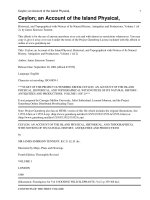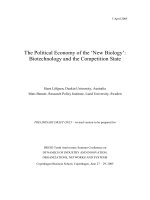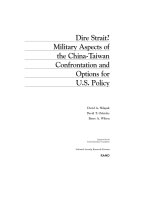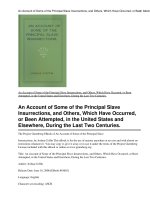university of california press fundamentals of the stem cell debate the scientific religious ethical and political issues dec 2007
Bạn đang xem bản rút gọn của tài liệu. Xem và tải ngay bản đầy đủ của tài liệu tại đây (2.09 MB, 228 trang )
Fundamentals of the Stem Cell Debate
The publisher gratefully acknowledges the generous
contribution to this book provided by the Barbara S. Isgur
Public Affairs Endowment Fund of the University of
California Press Foundation.
Fundamentals of the
Stem Cell Debate
The Scientific, Religious, Ethical,
and Political Issues
Edited by
Kristen Renwick Monroe,
Ronald B. Miller, and
Jerome S. Tobis
UNIVERSITY OF CALIFORNIA PRESS
Berkeley
.
Los Angeles
.
London
University of California Press, one of the most distin-
guished university presses in the United States, enriches
lives around the world by advancing scholarship in the
humanities, social sciences, and natural sciences. Its ac-
tivities are supported by the UC Press Foundation and
by philanthropic contributions from individuals and
institutions. For more information, visit
www.ucpress.edu.
University of California Press
Berkeley and Los Angeles, California
University of California Press, Ltd.
London, England
© 2008 by The Regents of the University of California
Library of Congress Cataloging-in-Publication Data
Monroe, K. R.
Fundamentals of the Stem Cell Debate: The Scientific,
Religious, Ethical, and Political Issues / Monroe.
p. cm.
Includes bibliographical references and index.
isbn: 978-0-520-25210-3 (cloth : alk. paper)
isbn: 978-0-520-25212-7 (pbk. : alk. paper)
1. Embryonic stem cells—Research—Moral and ethi-
cal aspects—United States. 2. Embryonic stem cells—
Research—Religious aspects—United States.
3. Embryonic stem cells—Research—Political aspects—
United States. I. Monroe, Kristen R., 1946–
II. Miller, Ronald Baker. III. Tobis, Jerome S., 1915–
[DNLM: 1. Embryonic Stem Cells—United States.
2. Biomedical Research—ethics—United States.
3. Human Experimentation—ethics—United States.
4. Public Policy—United States. QU 328 F981 2008]
QH588.S83F86 2008
174.2'8—dc22 2007031375
Manufactured in the United States of America
15 14 13 12 11 10 09 08
10987654321
This book is printed on Cascades Enviro 100, a 100%
postconsumer waste, recycled, de-inked fiber. FSC re-
cycled certified and processed chlorine free. It is acid
free, Ecologo certified, and manufactured by BioGas
energy.
To Paul H. Silverman, who pioneered work
in genome and stem cell research and whose
vision provided the drive behind this volume.
Paul passed away July 15, 2004. We shall
miss him.
Kristen Renwick Monroe, Ronald B. Miller,
and Jerome S. Tobis
1. Stem Cells 10
Peter J. Bryant and Philip H. Schwartz
2. Therapeutic Uses of Stem Cells 37
Philip H. Schwartz and Peter J. Bryant
3. Ethical Issues in Human Embryonic Stem Cell Research 62
Philip J. Nickel
4. Religious Perspectives on Embryonic Stem Cell Research 79
Mahtab Jafari, Fanny Elahi, Saba Ozyurt, and Ted Wrigley
5. Political Issues in the Stem Cell Debate:
The View from California 95
Lawrence S. B. Goldstein
6. Roots and Branches of the U.S. National Debate on
Human Embryonic Stem Cell Research 108
Lee L. Zwanziger
7. Stem Cell Politics: The Perfect Is the Enemy of the Good 134
Sidney H. Golub
8. Ethical Issues in Stem Cell Research, Therapy, and Public Policy 146
Ronald B. Miller
Epilogue 197
Kristen Renwick Monroe and Ted Wrigley
Contributors 203
Index 207
Contents
debate as the discovery of human embryonic stem cells. The potential
of these cells to replace diseased or damaged cells in virtually every tis-
sue of the body heralds the advent of an extraordinary new field of med-
icine that promises cures for diseases until now thought incurable.
These remarkable cells, therefore, have captured the imagination of
scientists and clinicians alike and have given patients a renewed sense
of hope.
Controversy exists, however, because the current technique to harvest
these cells involves destruction of the human blastocyst, a pre-embryo,
whether obtained by in vitro fertilization or by therapeutic cloning (so-
matic cell nuclear transfer). Too often, debate over the use of embryonic
stem cells forces discussion into two extreme positions. One camp argues
that we must either allow all stem cell research all the time or consider
ourselves responsible for failing to prevent the suffering and death of un-
told millions of human beings. The other camp argues that the use of em-
bryonic stem cells amounts to mass murder of young life. We wish to
avoid such polarizing debate, which oversimplifies complex issues, de-
monizes people of goodwill who hold differing opinions, and inflames
rather than informs policy discussions.
We do recognize the passion in the debate, however, and our discus-
sions in this volume respect the intensity of belief. While we do not speak
1
Introduction: Framing the
Controversy
Kristen Renwick Monroe, Ronald B. Miller,
and Jerome S. Tobis
for all the authors in this volume, the editors have tried to assemble
chapters that recognize that the crux of the controversy depends not
on an objectively derived or even a widely held scientific definition of
human life but rather on a personal definition, which in many cases
derives from religious faith and personal belief. Because of this, the
policy debate over the use of embryonic stem cells cannot easily be
resolved.
Indeed, the controversy is worldwide and many nations have en-
tered into internal deliberation on the subject. In the United States,
Congress has discussed the subject for several years; as we write, stem
cell legislation has been vetoed twice by President Bush on what the
president described as moral, not scientific grounds.
1
On a federal
level, therefore, only rules that establish the use of federal funds for
work with human embryonic stem cells have been established, and
these only by presidential initiative. On a state level, the rules vary
widely. For example, in California, such research is allowed but re-
productive cloning is not; in some states, all human embryonic stem
cell research is banned. The U.S. Congress is still considering legisla-
tion on stem cell research, and stem cells played a political role in the
presidential election of 2004, as they doubtless will in the next con-
gressional and presidential elections.
But public policies are made even in the midst of controversy, indeed,
often in the midst of controversy. One could argue that the majority of
issues related to science and technology—among others—are decided
with a public understanding of science or facts that is far from perfect.
Morality, science, and politics play no larger a role in the debate over
stem cell research than they did in the public discussions over smallpox
vaccination or abortion. While the hope is that improved public under-
standing of science will lead to better policies, this may be more useful
myth than actual reality.
2
The debate over embryonic stem cells is fur-
ther complicated by the lack of consensus among scientists. So the debate
over the use of human embryonic stem cells is one in which both scien-
tific and political advances move quickly, and stem cell research and its
political, scientific, and ethical climate are changing rapidly. It is because
of this debate that we have compiled a volume that presents a lucid dis-
cussion of the basic issues, in language that the public can understand.
This volume offers a broad overview of the essential aspects of the con-
troversy and encourages the kind of dialogue necessary to progress to-
ward a resolution appropriate for science, medicine, patients, ethics, and
public policy.
2 Introduction
organization of the volume
The stem cell controversy is framed by the late Paul H. Silverman, well-
known scientist and university administrator who, with Jerome Tobis,
initially proposed the conference that engendered this volume and who—
unfortunately—died shortly after the conference.
3
Silverman posed the
central question, for stem cells and for all scientific work with important
public ramifications: Are public decisions, on an issue that touches on
personal ethics and science, rooted in reason based on scientific knowl-
edge of stem cells and on reasonable predictions? Or do individual, faith-
based beliefs in the personhood or ensoulment of a fertilized cell carry
the day? For Silverman, the current controversy is part of an ongoing
struggle, since the time of the Enlightenment and the birth of the Age of
Science, between knowledge and belief or between reason and faith. Sil-
verman respected the individual conscience while coming down firmly in
favor of reasoned discourse and scientific knowledge when matters of
public policy are concerned.
In chapter 1, Peter Bryant and Philip Schwartz review the scientific
knowledge of stem cells and their potential both to proliferate without
differentiation and to differentiate into many, if not all, tissues. Bryant
and Schwartz differentiate embryonic stem cells from adult stem cells and
point out that many tissues undergo continual replacement from stem
cells. They note the tremendous therapeutic potential of stem cells in re-
placing damaged tissues or even whole organs. Their chapter is designed
to survey the current scientific knowledge of stem cells and to provide a
sense of what scientists know—and what they deem controversial—in
language accessible to the educated lay reader.
The next chapter, also by Schwartz and Bryant, brings a clinical per-
spective to the issue. The authors describe current established, thera-
peutic uses of stem cells for blood, immune, and metabolic disorders.
They then review the experimental therapeutic use of neural stem cells
for multiple sclerosis. Next, they discuss potential theoretical applica-
tions for Parkinson’s disease, spinal cord injury, retinal degeneration, di-
abetes mellitus, brain tumors, cardiovascular disease, metabolic disor-
ders, and osteoporosis. They discuss methods to abrogate or prevent
immune rejection, which greatly complicates stem cell therapy if the cells
are not genetically identical to the recipient. They conclude with discus-
sion of scientific and ethical issues arising in stem cell therapy. These two
chapters lay the foundation for understanding the scientific issues and
the clinical possibilities of stem cell research.
Introduction 3
Much of the controversy over stem cell research emanates from reli-
gious or ethical beliefs concerning the origin of life. Rather than adopt
either an adversarial position or one of advocacy, we chose to follow
Silverman’s admonition to address issues of science and religion in a
careful, scholarly way. In chapter 3, Mahtab Jafari, Fanny Elahi, Saba
Ozyurt, and Ted Wrigley thus survey the major world religions and ask
what each religion suggests about the origin of life and how this position
relates to broader issues concerning scientific research, including re-
search on stem cells. Jointly written by medical scientists and social sci-
entists, this chapter addresses what may be the most controversial ques-
tions concerning stem cell research: When does life begin, and how do
our views on that question influence our decisions about stem cell re-
search? The authors examine the views of the major religions concern-
ing the origin of life and suggest how one’s position on these important,
and highly charged, questions affects a wide range of issues concerning
scientific work. The chapter is important for two reasons. First, it offers
a dispassionate analysis of the various religious views, and second, it
broadens the discussion, moving away from the contrast between fun-
damentalist Christian religion and a “scientific” view to include a com-
parative, worldwide religious perspective.
Philip Nickel presents the view of a philosopher and ethicist con-
cerned with the ethical issues surrounding stem cell research. In particu-
lar, Nickel focuses on what he views as largely symbolic, but nonethe-
less highly charged, issues: the loss of potential future human life and the
moral standing or dignity of the embryo. Nickel argues that the critical
issues are not moral but rather are couched in statistical and political
terms: How many people support stem cell research, and how many op-
pose or are disgusted by embryonic stem cell research? Nickel’s chapter
provides a nice segue to what seems to be shaping up as the crux of the
debate over stem cell research: politics.
The next two chapters of the volume are devoted to the politics of
stem cell research. Larry Goldstein discusses stem cell politics prior to the
passage of Proposition 71, the California Stem Cell Research and Cures
Act. His is the view of a scientist in the trenches and a public-minded
citizen-advisor of legislators. Goldstein takes the position that his re-
sponsibility as a physician-scientist to present and future patients with
disorders potentially treatable with stem cells outweighs his responsibil-
ity to the early human embryo. He also points out that stem cell research
with human embryonic stem cells may allow an understanding of human
disease not currently possible from animal research. Finally, Goldstein
4 Introduction
discusses the greater value of public funding of scientific research as com-
pared with private funding, since public funding ensures public scrutiny
of research. Further, he suggests that we cannot avoid the difficult moral
choice by studying only adult stem cells because they may not have the
same potential as embryonic stem cells. He concludes that the policy is-
sues (moral, legal, and social) of stem cell research must be decided—as
they are for other controversial issues that affect society—by the demo-
cratic process.
Lee Zwanziger, a scientist-historian-philosopher, considers the poli-
tics of stem cell research from a national perspective. Zwanziger also dis-
cusses the importance of public funding for the oversight of research.
However, she believes agreement probably cannot be achieved simply by
greater public education about the scientific aspects of stem cell research
and technology because not all disagreement is due to ignorance of the
science. Rather, there is basic disagreement about the nature and moral
status of the early embryo, and this precludes agreement at least in the
near future simply by further public discourse or by democratic policy
decision making. Further, Zwanziger is not convinced that we need a
uniform national policy given the substantially different views that have
already been expressed by different states.
The chapters by Goldstein and Zwanziger describe the intensity of the
debate as it existed at the time of the initial conference, in May 2004, at
which several of these papers were presented.
4
These chapters locate the
controversy in politics, not science. In the last chapters, Sidney Golub
and Ronald Miller offer a synthetic analysis of the debate. Golub’s chap-
ter provides a current summary of federal, international, and state poli-
tics relative to human embryonic stem cells. It begins by reviewing fed-
eral legislation and regulation and the current impasse both in providing
federal support of human embryonic stem cell research and in passing
legislation that would ban cloning. Golub then reviews failed interna-
tional treaty efforts and the inability to agree even on a ban of repro-
ductive cloning. Finally, Golub reviews the variably enabling and re-
stricting legislation and regulation by different states. He predicts less
federal and more state funding and regulation of human embryonic stem
cell research in the future.
The final chapter, by Ronald B. Miller, serves as a summary of the eth-
ical issues in stem cell research, therapy, and public policy. Miller begins
with a brief recapitulation of normal embryologic development and the
sources of stem cells and then quotes a statement of ethical goals for stem
cell research. Next he reviews two issues of general societal agreement
Introduction 5
and two of major societal disagreement that complicate, if not prevent,
the development of satisfactory public policy. He then recapitulates the
religious as well as secular ethical beliefs and concepts fundamental to a
concluding overview of the ethical issues for stem cell research, stem cell
therapy, and stem cell policy development. He reviews the several scien-
tific strategies for obtaining potent human stem cells that have been pro-
posed to avoid critical ethical objections. In conclusion, Miller quotes
opinions regarding whether we can achieve societal consensus and pos-
sible approaches for doing so.
purpose of the volume
The debate over stem cell research is complex and complicated by di-
vergent religious views and by electoral politics. Our purpose in this vol-
ume is to present the major issues dispassionately, as a careful scientist
presents them, raising the complexities and controversies but doing
so in a manner that is accessible to the general public, since ultimately
stem cell research will be critically influenced, if not decided, by public
policies.
The issues raised here thus are important and of concern not just to
scientists and potential patients but also to the public. Does stem cell re-
search destroy human life? If so, is embryonic stem cell research justified
for broader humanitarian reasons? How will public decisions be made,
and what role will faith and science play in the decision making? Is there
sufficient scientific evidence of clinical benefit (or lack thereof ) to justify
political or policy decisions that promote or limit stem cell research? Do
we not need more basic and applied research before such decisions are
made? How will scientific research respond to the extant political reali-
ties and restrictions on embryonic stem cell research?
While these are perhaps the major questions of the debate, other ques-
tions also arise, and we hope readers will think of some of these issues
as they read the chapters that follow. Who owns the intellectual prop-
erty associated with stem cell research? How should the public receive a
return on its investment in stem cell research? Should genes be patented?
What will happen to the frozen embryos left over from in vitro fertiliza-
tion if they are not used for embryonic stem cell research? Are the Roman
and the American Catholic Church in agreement on these matters? Does
the Hippocratic tradition of doing no harm preclude embryonic stem cell
research? What is the moral status of a parthenogenetic blastocyst, a
blastocyst or early embryo derived from an unfertilized egg stimulated
6 Introduction
artificially to develop into an organism rather than one derived from a
sperm-fertilized egg? The parthogenote then is an organism derived from
a single individual rather than from two individuals or “parents.” Can
we reframe the public and scientific discussion to avoid language that po-
larizes the debate unnecessarily? Is the word embryo itself unnecessarily
polarizing? Is it scientifically precise? Is it useful to speak of a pre-
embryo? What about the term therapeutic cloning? Should we speak of
somatic cell nuclear transfer rather than cloning when we wish to gen-
erate new stem cell lines? Or is this language simply too technical and un-
wieldy for public discourse?
The contributors to this volume differ on several critical points, but
all agree that the first step toward good public policy is scientific knowl-
edge. As Zwanziger notes in chapter 6 of this book, failing to understand
the science will result in bad debate and can lead to bad policy, but un-
derstanding the science is not sufficient to ensure wisdom in either. The
difficulty is whether disagreement comes from ignorance of the facts or
from different interpretation of the meaning of the facts. We hope this
volume will contribute to increased public awareness of the scientific
facts and that such awareness will lead to more informed public opinion
and public policies concerning this important issue.
notes
1. The developments in this area move so quickly that some of what we now
write will surely be out of date. See the op-ed by Deborah Blum, “A Pox on Stem
Cell Research,” New York Times, A19, August 1, 2006, or Nicholas Wade’s
“Some Scientists See Shift in Stem Cell Hopes,” New York Times, August 14,
2006, A18.
2. See work on science technology by B. Wynne among others, or Blum, “Pox
on Stem Cell Research,” for a discussion of the debate over smallpox.
3. Paul’s was a passionate life in science, from his first research into malaria
vaccine to his work on the Human Genome Project. Paul established the nation’s
first human genome center in 1987 at the Lawrence Berkeley National Labora-
tory and later worked in university administrations to further scientific discov-
eries. He served as the provost for research and graduate studies at the State Uni-
versity of New York and as president of the University of Maine. He then moved
to the University of California at Berkeley, where he held a number of positions,
eventually becoming director of the Biotechnology Research and Education Pro-
gram for all the University of California campuses. His last official position was
as associate vice chancellor for the health sciences at UC Irvine.
We remember Paul as a Renaissance man who lived at the cutting edge of sci-
entific issues, even when these issues were controversial. This volume reflects
Paul’s conviction that the public can make wise choices if advances in science and
Introduction 7
technology are explained in clear and understandable language. We have tried
to honor Paul by following his lead in this volume, explaining the scientific is-
sues in language designed to be accessible to the educated lay reader. While the
volume attempts to present a balanced perspective, including a variety of schol-
arly opinions, we also wish to honor Paul’s passion about stem cell research by
noting his strong advocacy for broadening the use of this technique. Paul’s last
public remarks on this topic convey some of the fervor of his convictions on this
subject.
Paul argued, shortly before his death, that the “discovery of accessible human
stem cells and the subsequent research focused on clinical application inadver-
tently provoked an intersection of conflicting religious, philosophical, political,
scientific, and secular systems of belief.” In editing Paul’s remarks, the editors
have tried to retain the passion of Paul’s original piece while integrating it into a
volume that underwent significant editorial revision in response to the kind of
scholarly debate Paul so cherished. The editors appreciate the comments of the
other contributors, the anonymous reviewers, Ted Wrigley’s assistance in modi-
fying this document, and Nancy Silverman’s permission to publish it.
Paul linked many of the issues that arose as part of this debate to arguments
characteristic of the intense emotional debates of the seventeenth and eighteenth
centuries, when the Roman Catholic and Reformation churches reacted nega-
tively to the rational explanations of natural phenomena provided by scientific
processes. Paul felt that stem cell research and its potential application to the
treatment of a variety of incurable human illness have been greatly hampered by
political and judicial actions in several countries.
The United States, Germany, and France are but several prominent examples of this
phenomenon. For example, in the United States, President Bush announced on Au-
gust 9th, 2001, that scientists in the United States receiving federal funding were pro-
scribed from using new cell lines that might be obtained from frozen fertilized eggs
that were initially the by-product of in vitro fertilization procedures and were sched-
uled to be discarded. This left only the sixty or so stem cell lines already established.
About four hundred thousand of these embryos were estimated to be available in
2001, though many of those available were spoken for, and only a small proportion
could have been turned into viable stem cell lines. The announcement was accompa-
nied by language concerning sacredness of human life and the significant moral haz-
ards implicit in stem cell research and was promoted by the group of Evangelical
Christian congressional delegates.
In my view, this policy places severe limits on university scientists and laborato-
ries supported by funding from the National Institutes of Health. This constitutes a
significant portion of the research in the field. The proscription remains in place even
in spite of appeals from other conservatives, such as Strom Thurmond, Orrin Hatch,
and, very recently, Nancy Reagan.
As a result of the president’s religious beliefs, then, science administrative posi-
tions, advisory groups, and the judiciary are being filled with people who have been
active in advancing the religious understanding that the soul enters the egg at the
time of fertilization. This belief system has accounted for the numerous legislative
and judicial attempts to confer “personhood” even on the earliest multicell
embryos—the blastocysts, which contain the 120 harvestable stem cells [see chapter
1 of this book]—to grant them legal protection against scientific experimentation.
Some proposed legislation carries severe criminal penalties.
However, as is often the case, events have overtaken the concepts and thinking of
those who would declare criminals of those who might establish stem cell lines for
8 Introduction
study and experimentation. The cloning of Dolly the sheep by somatic cell nuclear
transfer (not fertilization) in 1997 demonstrated that the DNA nuclear hereditary
material from a highly specialized mammary gland cell can be reprogrammed to be-
come a totipotent embryonic stem cell capable of producing all of the more than two
hundred cell types required to make up a sheep’s body. The cloning of Dolly sug-
gested that any cell in the body can be reprogrammed to become another individual.
Cloning by somatic cell nuclear transfer has now been accomplished repeatedly and
efficiently in cattle, pigs, mice, and rats. Researchers at the University of Pennsylva-
nia have accomplished a remarkable transformation in in vitro cultures by converting
a specialized cell into a stem cell and then stimulating it to become a producer of
sperm. This has now been accomplished in vivo by the dedifferentiation of special-
ized cells into germline stem cells (Science, May 14, 2006). The significance of these
developments is that—theoretically, and soon practically—any of the ten trillion cells
in the human body, under appropriate conditions, can be converted into a potential
human. The newly discovered plasticity of the human genome is opening up new op-
portunities for regeneration and repair of diseased tissue.
Paul believed scientific reasoning and objectivity could alter strongly held be-
lief systems. One of his desires in proposing and crafting this volume was to re-
mind people that we live in a pluralistic, multicultural society, with tolerance
and respect for different worldviews. His hope was that the debate in this vol-
ume would encourage public policies and public policy debate based on such
principles.
4. The conference was sponsored by the University of California, Irvine
(UCI) Interdisciplinary Center for the Scientific Study of Ethics and Morality,
in co-sponsorship with the UCI’s Newkirk Center for Science and Society, In-
stitute for Genomics and Bioinformatics, Schools of Biological Science, Social
Science, Social Ecology, Medicine, Humanities, and Information and Computer
Science, Henry Samueli School of Engineering, and Paul Merage School of Man-
agement; the Children’s Hospital of Orange County; and the UCI Dialogue So-
ciety. We appreciate their support and that of Bettye Vaughen and Frank
Lynch, who contributed to the production of this volume. None of the individ-
uals or institutions acknowledged here, however, is responsible for the views
expressed in this volume.
Introduction 9
what are stem cells?
Stem cells are undifferentiated cells found in the embryos and the later
life stages of animals, including humans. They are recognized by their
dualistic nature: they either can expand their numbers (self-renew) while
remaining undifferentiated or can differentiate and contribute to the de-
velopment or repair of tissues of the body. Some authors have added
other criteria to the definition, including the ability to produce cells dif-
ferentiating in different ways (multipotency); the ability of a single cell
to proliferate into a population of similar cells (clone-forming ability);
and the ability to keep dividing indefinitely (unlimited proliferative
capacity)—the latter property distinguishing them from most other non-
cancerous cell types, which can undergo only a limited number of divi-
sions. In most examples of stem cells only some of these properties have
been demonstrated, and the term stem cell has been used fairly loosely.
However, stem cells of many types are now being intensively studied by
genetic and molecular methods, and biologists are developing more rig-
orous and convenient methods to identify them. They are recognized by
their expression of certain genes, their production of characteristic pro-
teins and antigens, and their responsiveness to certain growth factors.
In the best-analyzed examples of stem cells in experimental organisms,
self-renewal is accomplished through conventional symmetric cell divi-
sion (figure 1), whereas differentiation is controlled through a specialized
10
chapter 1
Stem Cells
Peter J. Bryant and Philip H. Schwartz
mechanism called asymmetric cell division (ACD; figure 1). ACD results
in the budding of a (usually) smaller cell from the larger stem cell (Potten
1997). Through this division the stem cell renews itself and can undergo
more such divisions, while the other cell either begins to differentiate or
undergoes a small number of additional divisions before the resulting cells
differentiate.
When a cell begins the process of ACD, one set of specialized proteins
accumulates on one side of the cell and another set accumulates on the
other (figure 2). These proteins (and some messenger RNAs) are then in-
cluded either in the stem cell or in the differentiating cell. Furthermore,
experimental studies show that these localized molecules actually control
whether the cell receiving them remains a stem cell or begins differenti-
ating. The molecules are therefore called ACD determinants. Most of
them have been identified through genetic studies of ACD during the de-
velopment of the nervous system in the fruit fly Drosophila. In the ab-
sence of any one of the ACD determinants the asymmetry of division is
disrupted, and this leads to abnormal cell proliferation and/or abnormal
cell fates. Some of the ACD determinants control the localization of
Stem Cells 11
Figure 1. The fundamental characteristics of stem cells: (A), Symmetric cell di-
vision leads to self-renewal of stem cells; (B), Asymmetric cell division leads to
replacement of the stem cell and production of a sister cell, exemplified here by
a neural precursor, which may differentiate immediately or after one or a few
divisions. Specifically expressed and localized stem cell determinants dictate
the fate of the daughter cells.
[To view this image, refer to
the print version of this title.]
others, and the molecular interactions between them are under active
study (Matsuzaki 2000).
Most of the proteins implicated in ACD in Drosophila have remark-
ably close mammalian and human counterparts (homologs), but there is
only fragmentary evidence regarding the possible roles of these homologs
in the control and division of mammalian stem cells. Much of the infor-
mation comes from work on the formation of the nervous system in the
mammalian embryo, where ACD has been demonstrated in the mouse
(Shen et al. 2002) and ferret (Chenn and McConnell 1995). Preliminary
studies have suggested that ACD during mammalian development is con-
trolled by the homologs of some of the ACD determinants identified in
Drosophila, including those named Numb, Numblike, Notch1 (Fang
and Xu 2001; Justice and Jan 2002; Zhong et al. 1997; Zhong et al.
1996), and LGN (homolog of Drosophila Pins; Fuja et al. 2004;
Mochizuki et al. 1996). In one of the most definitive studies, stem cells
12 Stem Cells
Figure 2. Fluorescently labeled ACD determinants during division of a neural
stem cell in a fly embryo, showing the opposite localizations for ACD determi-
nants in the stem cell and differentiating cell. The Miranda protein, stained
red, marks the basal complex that determines the differentiating neural precur-
sor and also includes Staufen, Prospero, Prospero mRNA, Numb, and Pon.
The Pins protein, stained green, identifies the apical complex that determines
the neural stem cell and also includes Atypical PKC, Gαi, Bazooka, and Insc.
Image from Chris Doe, University of Oregon.
[To view this image, refer to
the print version of this title.]
were isolated from the living embryonic mouse brain and cultured
through a division cycle, and the resulting cell pairs were stained using
antibodies against the Numb protein (Shen et al. 2002). The protein
often accumulated in one of the two daughter cells, and this accumula-
tion was correlated with the subsequent fates of the daughter cells. The
Notch signaling pathway, identified genetically in Drosophila, also
seems to be involved in ACD of satellite cells during mammalian muscle
development (Conboy and Rando 2002).
The fate of stem cells as well as the way they divide appears to be
a function of their microenvironment, which in many cases is provided
by a specialized structure known as the stem cell niche. At least in the
hematopoietic (blood cell–forming) system, the niche develops indepen-
dently and the stem cells migrate to and colonize the niche (Schofield
1983). It has been suggested that the niche controls the phenotype of the
stem cell, including whether it undergoes self-renewal or ACD. Evidence
suggesting the existence of stem cell niches has also been obtained for the
epidermis, intestinal epithelium, nervous system, and gonads (Fuchs,
Tumbar, and Guasch 2004), as well as in developing muscles (Venters
and Ordahl 2005). Furthermore, some of the soluble growth factors me-
diating interaction between niche and stem cells have been identified
(Hauwel, Furon, and Gasque 2005).
embryonic stem cells (escs)
In the mammalian embryo, following fertilization of the egg by a sperm,
several cell divisions take place without any growth in total volume (fig-
ure 3), so the cells (now called blastomeres) get progressively smaller.
They also rearrange to form a hollow sphere of cells (blastocyst) sur-
rounding a fluid-filled cavity called the blastocoel. The cells of the blas-
tocyst then segregate into an outer layer, called the trophectoderm, and
an inner cell mass (ICM). The cells of the trophectoderm (trophoblasts)
become the fetal contribution to the placenta, while the ICM contains
the embryonic stem cells (ESCs) that give rise to the tissues of the fetus
(figure 4).
Isolation
Human ESCs (hESCs) are usually obtained from the ICM of embryos pro-
duced by in vitro fertilization (IVF). In this procedure, eggs are harvested
Stem Cells 13
from a woman after she has been treated with follicular hormones to stim-
ulate the ovaries. The eggs are fertilized either by combining them with
sperm in a dish or by mechanically injecting the sperm into the egg (intra-
cytoplasmic sperm injection). The latter technique has the advantage that
every egg gets fertilized and that only one sperm enters each egg. The fer-
tilized eggs are then incubated to allow them to develop into blastocysts.
Then the trophectoderm is removed and the ICM is plated on to a “feeder
layer” of mouse or human embryonic fibroblasts (Thomson et al. 1998),
which is essential for the survival of the ICM (Cowan et al. 2004). The
ICM then flattens into a compact colony of ESCs. ESC colonies are then
14 Stem Cells
Figure 3. Early development of the human embryo. Embryonic stem cells are
derived from the inner cell mass of the blastocyst. See text for explanation.
[To view this image, refer to
the print version of this title.]
mechanically dissociated and replated several times to give rise to stable
cell lines.
Properties
Under certain conditions hESCs can divide indefinitely while undiffer-
entiated, but under other conditions they can differentiate into virtually
any cell type in the body (Amit et al. 2000; Bodnar et al. 2004; Cowan
et al. 2004; Odorico, Kaufman, and Thomson 2001; Thomson et al.
1998). When undifferentiated hESCs are transplanted into an animal,
they often form a type of tumor called a teratoma (Altaba, Sanchez, and
Dahmane 2002), which is unusual in that it contains cells representing
all three germ layers (Trounson 2004). Indeed, the ability of hESCs to
form a teratoma after injection is the accepted criterion for identifying
hESCs as such.
When cultured in the laboratory, hESCs grow as compact colonies
and usually require the presence of “feeder cells” for their survival (fig-
ure 5). The feeder cells are typically mouse fibroblasts that have been
treated with mitotic inhibitors to prevent their proliferation. But to make
hESCs safe for use in human cell therapy, methods are being developed
in which the human cells have no contact with animal cells. Human
feeder cells can be effective (Amit et al. 2000). Another possibility is to
first condition the culture medium by incubating it with feeder cells, then
Stem Cells 15
Figure 4. Products of the different cell types of the early blastocyst. The cells
of the trophoblast give rise to the fetal component of the placenta, while the
inner cell mass, the embryoblast, gives rise to every cell type and organ system
of the body.
[To view this image, refer to
the print version of this title.]
remove the feeder cells and use the conditioned medium, presumably
containing appropriate growth factors, for culturing the stem cells (Car-
penter et al. 2004; Rosler et al. 2004; Xu et al. 2001).
Human ESCs have specific requirements for nutrients, including
“serum replacement medium.” Serum is a necessary component for sur-
vival and/or differentiation of many cell types, but it invariably induces
differentiation of hESCs, so it cannot be used to promote their survival
and/or proliferation. This problem has been overcome by the use of
serum replacement medium, which has many of the supportive proper-
ties of serum but lacks the tendency to cause differentiation. Another fea-
ture of hESCs is their inability to divide and/or survive in low-density cul-
ture. When they are dissociated into a single cell suspension, these cells
have a very low survival rate. Colonies are therefore usually mechani-
cally dissected into smaller colonies, rather than dissociated into single
cells, for propagation.
Human ESCs in culture have a specific morphology, and they express
characteristic surface antigens and nuclear transcription factors. The sur-
face antigens include the stage-specific embryonic antigen SSEA-4 and
the teratocarcinoma recognition antigens TRA-1–60 and TRA-1–81
(Carpenter et al. 2004). The transcription factors include the POU (pit-
oct-unc)-domain transcription factor Octamer-4 (Oct-4), associated
with the expression of particular elements of the embryonic genome
(Thomson et al. 1998).
16 Stem Cells
Figure 5. Human embryonic stem cells in culture. Phase-contrast photomicro-
graphs taken at (A) 40x, (B) 100x, and (C) 400x magnification. Human ESCs
appear as colonies of cells (white arrows) that are so tightly packed that indi-
vidual cells are very difficult to discern, even at high magnification. The
colonies are grown in the presence of a feeder layer of cells, in this case mouse
embryonic fibroblasts (black arrowheads). Even when hESCs are grown under
conditions that do not favor differentiation, they spontaneously differentiate
and are then seen as groups of less tightly packed cells emanating from the
sides of the colonies (white arrowheads).
[To view this image, refer to
the print version of this title.]









